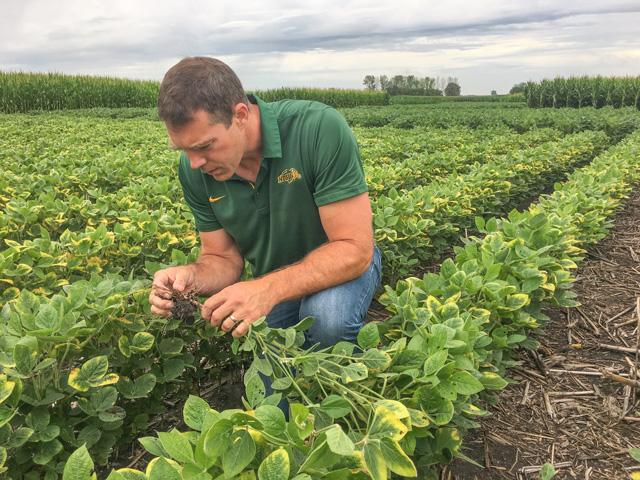Catch Soybean Cyst in the Act
Dig Now to Root Out Soybean Yield Robber SCN
DECATUR, Ill. (DTN) -- This is the perfect time of year to do a little digging to see if soybean cyst nematodes (SCN) are dining in soybean fields at your expense.
It's easy.
Grab a shovel or a trowel. Dig up the entire plant, taking care to include the roots.
Look at the roots closely for little white granules -- much like grains of salt or sugar. They will be about one-tenth the size of the healthy nitrogen-fixing nodules that should also be present. Need a closer look? Carefully wash off the soil. Place the roots against something black or use a hand lens for magnification.
Spot these little white dots, and you've found the SCN maternity ward. These little specks are SCN females waiting to give birth to another generation -- all the while feeding on soybean roots and sucking the life out of potential yield. Finding them gives clues as to next management steps.
P[L1] D[0x0] M[300x250] OOP[F] ADUNIT[] T[]
A new collaboration between the SCN Coalition and Valent has been formed to urge farmers to perform these simple in-season checks.
North Dakota State University plant pathologist Sam Markell said SCN is sneaky because soybean plants may look perfectly healthy above ground while nematodes are feeding. Adult SCN females can be detected on the roots of infested plants as soon as six weeks after soybeans have emerged. This video explains how to check roots: https://www.youtube.com/….
Detecting SCN females on roots provides an indication if current tools used to manage SCN are effective.
If you planted an SCN-resistant soybean variety but still discover females on the roots, coalition leaders encourage testing soil for SCN after harvest and talking to trusted crop advisers or Extension specialists to develop an SCN management strategy.
WHY YOU NEED TO TEST
Broadening the understanding of why the most common source of SCN resistance known as PI 88788 has been struggling to protect the crop is part of the new educational campaign between The SCN Coalition and Valent. The push is on to explain why farmers should test their fields to know their SCN numbers, the importance of rotating to non-host crops, why it's critical to rotate SCN-resistant varieties, and how a nematode-protectant seed treatment can offer another level of protection against SCN.
Markell said SCN females will swell with 100 to 200 eggs and may go through multiple life cycles, depending on region of the country, before changing to hardened cysts that protect the eggs in the soil. North Dakota may have two to three generations, for example, while Missouri has three to six, he said.
"Each time they go through one of these generations, the levels are increasing in the field," Markell added. "If you are planting a resistant variety and spotting a lot of white females in-season, it likely means that variety is not holding up under SCN pressure very well."
It's also a clue the field needs a serious soil-testing program to identify what levels are present and create a management program using different sources of resistance and/or treatments to start reducing SCN levels to try to control yield loss.
Share pictures of your root check on social media by tagging @TheSCNCoalition on Twitter and Facebook and by tagging @ValentUSA on Twitter and @WeAreValentUSA on Facebook.
Pamela Smith can be reached at pamela.smith@dtn.com
Follow her on Twitter @PamSmithDTN
(c) Copyright 2022 DTN, LLC. All rights reserved.





